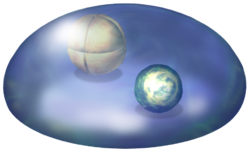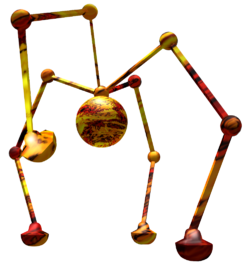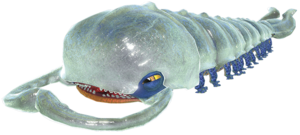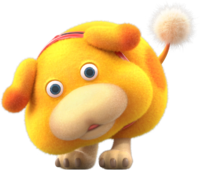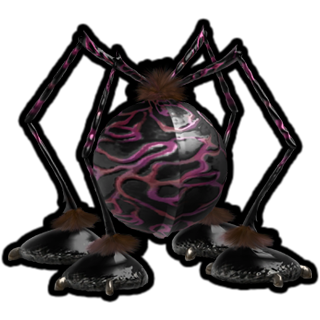User:NintendoPanda101: Difference between revisions
(Honeywips and Mitite) |
|||
| Line 37: | Line 37: | ||
[[File:Fiery Bulblax P4 icon.png]] | [[File:Fiery Bulblax P4 icon.png]] | ||
The Fiery Bulblax, also known as the Knighted Grub Dog, or Oculus Volcanus. The Fiery Bulblax shares the melted features and protective hide of the Emperor Bulblax. It's behavior is more akin to the common grub dog. It's highly resistant to attack beyond it's flame coating, which comes from secretions of a highly flammable wax. This wax reacts to chemicals in the Bulblax's cell structure, creating this fire. It has a highly spongy cell stucture to spread the heat more evenly, and protect the inner organs. This creature is rare, as it often sets fire to plantlife nearby, and, if a large amount of vegetation is nearby, can end up getting itself killed in the inferno. | The Fiery Bulblax, also known as the Knighted Grub Dog, or Oculus Volcanus. The Fiery Bulblax shares the melted features and protective hide of the Emperor Bulblax. It's behavior is more akin to the common grub dog. It's highly resistant to attack beyond it's flame coating, which comes from secretions of a highly flammable wax. This wax reacts to chemicals in the Bulblax's cell structure, creating this fire. It has a highly spongy cell stucture to spread the heat more evenly, and protect the inner organs. This creature is rare, as it often sets fire to plantlife nearby, and, if a large amount of vegetation is nearby, can end up getting itself killed in the inferno. Despite appearance, the two differently shaped eyes are not a result of the inferno, but a normal feature of the Bulblax. | ||
===Day 5: [[Burrowing Snagret]]=== | ===Day 5: [[Burrowing Snagret]]=== | ||
Revision as of 19:23, September 8, 2023
Welcome to Ninpan's Daily Creature Feature.
On this page I will have a daily writing on a Pikmin creature. This will include minor headcanon content, such as technical names for enemies that didn't appear in Pikmin 1, and ignoring basically everything Pikmin 4 has to say about Pikmin 1 enemies. When I started this on this wiki, I was already up to day 10 on a Discord server. I will not be covering Hey Pikmin enemies. Feel free to fix any typos!
Day 1: Emperor Bulblax
Emperor Bulblax, also known as Oculus Supremus or the Emperor Grub-Dog, is a young version of the final boss of Pikmin 1. It hides underground to ambush prey, either using its rocklike hump to disguise as a stone or using its eyestalks as camouflage in sandy environments. The method of camouflage it uses depends on how mossy its back is, which can also grow plantlife. It has a long purple tounge it uses to capture prey, and it can be tricked into eating pretty much anything. It exhibits pack behavior and a larger version has been found, in-between the Emperor and Sovereign Bulblax, named the Heir Bulblax.
Day 2: Goolix
Goolix, also known as the Greater Water Slime, or Binuclei Siphonophores, is a gigantic single celled organism with a body comprised of a watery membrane. It is a major boss in the first game, however it is completely optional, only appearing in a stump battle room in the first area, odd days starting day 9. It appears from thin air, possibly disguising as a simple patch of moisture in the ground, similar to the nectar droplet disguise of it's single nuclei'd cousin, Foolix. It will stretch its body to absorb prey, although non Blue Pikmin are simply left suffocating with a bubble on their head. The crystal nucleus is the creature's nervous system, while the fleshy nucleus is the creature's defense system, weakening prey and absorbing nutrients. Most prey will drown before the absorbtion process begins. Sudden change in weight on either nucleus will cause the Goolix to lose control of it's shape, slamming its nuclei together and injuring it in the process.
Day 3: Beady Long Legs
The Beady Long Legs is a large spider-like creature also known as the Arachnorb or Psuedoarachnia Armoralis. It is a boss in the first 2 games, being the only boss with a unique theme other than the Sovereign Bulblax. It falls from what seems to be the sky to scare off intruders with footfalls. It has no natural predators, not only due to size and high resilience, but also its armor like wax coating, which gives it its unique pattern. This armor may be to ward off parasites, as insects tend to climb up the legs of unwaxed relatives, namely the Shaggy Long Legs. The Beady Long Legs is known to make webs, but its feeding habits are unknown. Like other Arachnorbs, it has an oddly destructive death procedure. When it's weakened, it will start to flake away, and will smoke at the joints. When it dies, a jolt of electricity surges through it, and it either explodes into fireworks and smoke, or disintegrates as it falls to the ground.
Day 4: Fiery Bulblax
The Fiery Bulblax, also known as the Knighted Grub Dog, or Oculus Volcanus. The Fiery Bulblax shares the melted features and protective hide of the Emperor Bulblax. It's behavior is more akin to the common grub dog. It's highly resistant to attack beyond it's flame coating, which comes from secretions of a highly flammable wax. This wax reacts to chemicals in the Bulblax's cell structure, creating this fire. It has a highly spongy cell stucture to spread the heat more evenly, and protect the inner organs. This creature is rare, as it often sets fire to plantlife nearby, and, if a large amount of vegetation is nearby, can end up getting itself killed in the inferno. Despite appearance, the two differently shaped eyes are not a result of the inferno, but a normal feature of the Bulblax.
Day 5: Burrowing Snagret
The Burrowing Snagret, also known as Shiropedes Annacondi, and the White Headed Snavian, is a bird serpent hybrid that serves as a weak boss that often appears in groups. It lives underground, emerging and pecking with great speed to capture prey. When unearthed from the ground, a single foot can be seen. Snavians are the most distributed family other than the Grub Dog family, being seen in almost all regions. While it's not very common to find a Snavian due to large size, one should still expect one to be living in any region they enter. The Burrowing Snarrow, a relative of the Snagrets, has yet to be studied in detail. Observations include tail markings, a white and fat body, and a more scruffy head.
Day 6: Wollyhop
Wollyhop, also known as the Amphibituber and Amphicaris Albino, is a member of a frog like family known for vaguely resembling potatoes. They are also known for their behavior of crushing opponents by jumping high in the air and inflating their jowls, deflating to fall back down and crush anything with their weight. The Wollyhop is the original member of this species, and while once a blue color, has become albino due to cave dwelling. Wollyhops are the most aggressive member of the family, as while other members crush foes to protect eggs, the Wollyhop seems only to do so out of spite, even going out of the way to crush other creatures when nightfall comes. They also have keen senses, being able to detect intruders from behind. The Wollyhop was once considered one of the most dangerous species to Pikmin, but with the discovery of the crush proof Rock Pikmin, this is no longer the case.
Day 7: Segmented Crawbster
The Segmented Crawbster, also known as the Carcinized Pillbug, and Parastacoidea Reptantia, is a large crawfish/lobster like creature, showing a large, spiked claw not unlike a club, with a proper claw, albeit small, on its left. This creature has an incredibly aggressive disposition despite its goofy looking eyes, and will ram into prey at full speed, rolling into a ball and causing avalanches with the severity of the impact. It's actually an herbivore despite its aggression, considered one of the most well defended herbivores besides the waxed members of the Arachnorb family. On it's underbelly is a large red bulge, not unlike a zit. This bulge can be damaged and contains vital organs, and when damaged too much, explodes as the Crawbster writhes in agony. The contents of the stomach are released when it explodes, allowing effective, if not cruel study of the Crawbster's diet. It seems to prefer habitats that were once inhabited by an unknown intellegent species (humans), only being found in what appears to be a room of tile.
Day 8: Mamuta
Mamuta. Also known as Hortanulus Assymetria or the Great Protector Statue, these creatures are incredibly odd. Their assymetric shape and piercing gaze make them seem threatening, but they are actually incredibly gentle. They seem to have a connection with Pikmin, the patterns on the wrist matches the pattern seen on Onions, Pikmin nests. These patterns are only seen on the inorganic onions, implying an even further connection. Mamutas will often be found relaxing, but if angered, will pound any attackers into the ground. If these attackers are Pikmin, they will be planted into the ground and grow a flower. Mamutas do not take kindly to these Pikmin being pulled out of the ground. The Mamutas are proper gardeners, growing fields of crops for food and flowers for decoration. Underground specimens are inherently aggressive due to lack of food. When relaxing, Mamutas have been known to purr or create donkey like sounds. Mamuta eyes actually have white to them, which may make for an unsettling thought, but they are quite cute once you get used to them.
Day 9: Breadbug
Breadbug, also known as the Vanilla Breadbug and Pansarus Gluttonae. This little guy is a bumbling scavenger which will take anything it can pull back to its nest or another hiding spot. They have a strong grip and very thick skin, protecting them from almost all attacks. They seem to enjoy music, as they can be found humming various tunes while out and about. The Breadbug shares several similarities with Grub Dogs, and in fact share the same vocalizations. This makes it rather likely that Breadbugs and Grub Dogs have a common ancestor. Breadbugs have become a favorite for researchers, who find them heart melting. The inside of its nest is quite huge, and with proper food sources, a Breadbug can live up to 20 years with minimal signs of aging. Breadbugs are an elusive prey species, as their blubber makes them impossible to chew down on. Nevertheless, Grub-Dogs have an interest in Breadbugs, leading to the evolution of various Breadbug mimics, various species of Breadbug that look almost exactly like Grub Dogs.
Day 10: Sovereign Bulblax
The Sovereign Bulblax is an incredibly old Emperor Bulblax, and shares the same nicknames. This massive creature is about half the size of a tire rim, and is by far one of the strongest creatures on the Distant Planet. It does not share pack behavior with its younger counterpart, and it can jump 3 times its size into the air to completely crush any prey, turning their bones into dust. This horrifically durable creature can survive swallowing over 30 bomb rocks. Much larger vegetation grows on its back than in it's younger state, including Blaxcaps and Bulborle. The specimen shown in this image has Bulborle. To find out the age of a specimen, one can count age rings on its hide, specimens with over 100 age rings have been discovered. Captain Olimar fought this creature as his Final Trial when he crash landed on the Distant Planet, a much older specimen, possibly around 250 years old. It did not die, and merely retreated into the ground. The only creatures known to rival the Sovereign Bulblax are Man-At-Legs, Raging Long Legs, armed Titan Dweevils, Plasm Wraiths, and Ancient Sirehounds.
Day 11: Smoky Progg
The Smoky Progg, also known as The Great Crumbling Statue and Magovum Vaporus, is a malformed larval Mamuta. Mamuta lay large eggs, and through a variety of factors, the fetus can deform. This can range from consumption of strange substances from the parent or intense impact on the egg. The green melting skin is supposed to turn into a Mamuta's normal skin in high temperatures. This creature can shoot and leave behind hazardous toxic sludge known as gloom. A golden pearl seems to constantly regenerate the melting creature, and seems to be what a Mamuta heart looks like. This pearl can produce an enormous amount of Pikmin when taken to an onion. Mamuta will often create odd patterns of soil around eggs, possibly as markers. When a Smoky Progg is born, it is inherently aggressive towards all but adult Mamuta, the Mamuta will attempt to take care of the creature as one of their own, but it will not last. A Progg in the family will discourage Mamuta colonies reproduction for months, sometimes even years.
Day 12: Foolix
Foolix, Mononucleui Stellacodus, or the Greater Mimic Slime. This water slime mimics a drop of nectar, a common sight on the distant planet, in order to lure in prey. Unlike the Goolix, prey are absorbed alive, with secretions from the lumpy nucleus. The flagella on the nucleus control the organism's gelatinous body, which can split into pieces during dire circumstances. It is immune to most elemental attacks, and while it doesn't have as high durability as the Goolix, it is still unlikely uncoordinated species can kill the organism. Two members of the opposite sex can merge and take a form similar to the Goolix, but it is unknown if the Goolix is indeed two opposite sexed specimens merged. Fooli often let themselves be consumed, so they can overtake the eggs in pregnant females. Nectar is often found in the eggs of this planet, so this strategy ensures a sucessful hunt.
Day 13: Purple Pikmin
Purple Pikmin, also known as Pikminidae Yokozunum and the Feeler Carrot, are a species of Pikmin known for their bulk. Their sheer weight for their size will injure creatures they land on, and sometimes even briefly dizzy them. The Purple Pikmin can carry 10 times as much as other Pikmin types, a small group can carry even the largest of creatures. Their feelers let them detect the world around them, and also seem to give them a homing sort of ability when they fall, allowing them to hit creatures dead on. Purple Pikmin have very good balance, and trip less than other types. They also can resist high winds and pop bubbles they get trapped in instantly. They have a strong resolve that lets them stow away fear as well, seemingly as a drive to protect other Pikmin types. The color comes from rich polyphenol antioxidants, which allows the Purple Pikmin to ward off disease. Their incredibly dense muscle fibers slow them down when moving, Purple Pikmin seem to be one of the earliest types to evolve, and they remained underground alongside their Onions for a long time, warding off the high amount of hostile species with their strength.
Day 14: Giant Breadbug
The Giant Breadbug, also known as Pansarus Gigantus and the Umami Breadbug, is a large, durable, member of the Breadbug family. It shares similar behavior to the Breadbug, but has increased durability. It's a very malleable creature, and has durable internal organs, so pretty much nothing poses a threat to this massive creatures life. The only exception is sustained attack from weapon wielding creatures, or stomps from the largest on the planet. For a short period after birth before it matures, it competes with Breadbugs for the same food sources. When it grows, it seeks much larger prey, and will often nest with Breadbugs. When annoyed, the Giant Breadbug will run full speed into other creatures. This is often enough to drive them away. The Giant Breadbug is known to mate for life, and make for very defensive parents.
Day 15: Armored Mawdad
The Armored Mawdad, also known as Tuberclipeum Rex and the Crystalline Veggiepede, is a large predator that hollows out tree stumps and sometimes caves. It will eat just about anything, the contents of its stomach often being a surprise. Its hunting strategy is simply charging into prey at full speed, trapping it with its mandibles. It can stick to walls and attack from just about anywhere. When growing, it will molt its shell by aggressively ramming into walls to destroy its shell. The shell is made of a glass like biological substance, and when shattered the Mawdad will experience a sharp pain. The mandibles are also made of this glass like material, and are hollow, the creature having no actual mandibles on its body. When it dies, its armor shatters, the exact reason being unknown. This creature is quite new to the ecosystem, and shows promise for becoming a highly effective predator. It seems to be growing in population due to the clearing of treasure, objects from a lost civilization, in a large area by explorers. The Mawdad being an opportunist of an eater, would often consume these treasures and choke on them.
Day 16: Armored Cannon Beetle
The Armored Cannon Beetle, also known as the Horned Lithopod and Granitus Chukkulinae, is an adult lithopod, a family known for eating stones. Using compressed inhaled air, stored in a bladder, it will shoot partially digested stone fragments to ward off predators. This species is a migratory one, coming to the region during a global climate shift in the last century. It has the strongest armor of any member of the Lithopod family, a hard exoskeleton lined with iron. The large protrusion is a blowhole, through which it inhales. This blowhole closes for female adults. If clogged, the Armored Cannon Beetle will be unable to vent body heat, forcing it to open its plating and vent through pores in its backside. The Armored Cannon Beetle will also spit rocks with much less force to leave them laying around. Females will lay eggs on these boulders, and when the eggs hatch, the larva will gain the metabacteria they need to digest stone. The Armored Cannon Beetle has been slowly declining in numbers, as the other lithopods in the region recover from its new arrival to the ecosystem. These numbers are expected to balance out in the near future.
Day 17: Anode Beetle
The Anode Beetle, also known as the Shelled Scarab Beetle and Scarabum Electrodea, is a small shiny creature that has what can be described as an internal battery. By creating friction on the ground with microscopic hairs, which it does by either sliding across the ground or walking in a wobbly manner instead of walking normally, it will charge its battery. This electricity can actually be used for energy by the beetle, meaning it can go without eating for a very long time, the only risk being malnourishment. Large thuds near the beast will startle the hairs, panicking the creature and causing to flip over. If hit directly on the back of its shell, it will similarly panic. This creature gives off faint electric waves, and when discharging excess electricity at the same time as another beetle, the two charges will connect and create a devestating line of electricity from what is normally a harmless discharging procedure. These beetles do not actually have any pack instincts, only appearing in groups to take advantage of their electric connections. The feelers allow them to detect each other, but beyond this, they have very little social behavior.
Day 18: Rescue Pup
Rescue Pups, also known as the Heroic Space Dog and Folicanis Amicaris, are a species native to the Distant Planet. Long ago, the species somehow found its way into space. Rescue Pups are among the most loyal types of space dogs, and are often used for rescue services among other things. They have very high intellect and durability, and can pull things up to 10 times their weight. The leafy specimen is named Moss, and has lived on the Distant Planet her whole life. She is bigger than any other breed of Rescue Pup, and due to high exposure to Pikmin, was born with a leaf. This leaf doesn't allow her to leave the Distant Planet. Rescue Pups can breath oxygen, making rescue operations on dangerous planets full of the poisonous gas much safer. It is unknown what the population of Rescue Pups is like on the Distant Planet, as no relative of Moss has ever been discovered.
Day 19: Winged Pikmin
Winged Pikmin, also known as Flying Carrots and Pikminidae Volarosa, are among the newer discoveries in the Pikmin family. Winged Pikmin should logically be the most common type, however due to lackluster strength, and the inability to fly too high before the lowering air pressure disturbs their spatial awareness, they are just as common as Rock Pikmin in the wild. Their goggle like eyes allow them to see wind direction. It is theorized that long ago, a primitive Onion absorbed a flying creature, and used the DNA to create this type of Pikmin. If true, Winged Pikmin likely evolved from White Pikmin, who share a similar size and eyes. Winged Pikmin are known to spread the seeds of various plantlife, it is unknown whether this is an intentional attempt to boost the ecosytem's variety, or just unintenional behavior.
Day 20: Raging Long Legs
The Raging Long Legs, Pseudoarachnia Furiendis, or the Black Widow Arachnorb, is a large female arachnorb, the male version of the species being smaller, closer to other arachnorbs in size. The Raging Long Legs is the only arachnorb known to have a gender difference like this, and it often kills the father of its young, similar to a black widow. The Raging Long legs is a waxed Arachnorb like Beady, but also has a thick layer of what seems to be blubber, making it even more resilient. It shares qualities with later evolved arachnorbs, such as toes and hair, although the toes are more like claws than the toes seen in other species. The Raging Long Legs is very protective, and will fly into a rage if attacked, stomping incredibly fast. Otherwise it's rather calm, gladly sharing a nest with many other creatures. It levels land to create an environment to take care of its young. Young Raging Long Legs grow in 6 months, and the mother will give birth up to 10 times in its life. This makes it a prime target of Mitites, a parasite species that gets eaten by females to lay their own eggs into the developing eggs of the host.
Day 21: Honeywisp
The Honeywisp, Nektara Fatuus or the Nectar Specter, is an elusive sea monkey like creature. It has a transparent ekoskeleton that allows it to float on the wind, and it can hide the honeywisps main body, making it essentially invisible. The main body is actually quite sturdy, though its structure utterly collapses on death. It feeds on exclusively nectar, which it is always found carrying. It can expand its lower body to envelop a drop of nectar, or use its suction cup to transport an egg. It will envelop the egg in order to hide it when "vanishing". It often is seen taking these to its nest and awaiting larvae. If fed spicy nectar, growth will increase, if fed bitter nectar, growth will slow. The wisp is colorblind, so it can't identify these colored nectars. The Honeywisp is notorious for tremendously increasing the range of the Mitites, who often live inside these eggs.
Day 22: Mitite
The Mitite, also known as the Intruder Insect and Mitivius Infiltratus, are a highly successful parasitic species. Mitites release a smell that drives female creatures wild, and drives them to swallow Mitites whole, even herbivores will do this. The Mitite will then bore a hole through the creatures stomach, find the womb, and lay eggs inside. When the creature lays eggs, it will be full of highly compact Mitites, ready to be released from the egg. Asexual creatures such as Pikmin abhore the scent, although Purple Pikmin are for some reason unphased. Mitites are full of nectar, as they will often eat the developing yolked fetus while inside an egg. Mitites can also be found living underground, where loud sounds such as a Bulblax roaring will awaken them. Mities full of spicy nectar have been found underground, so it seems that their diet outside of developing fetuses comprises mostly of nectar.
